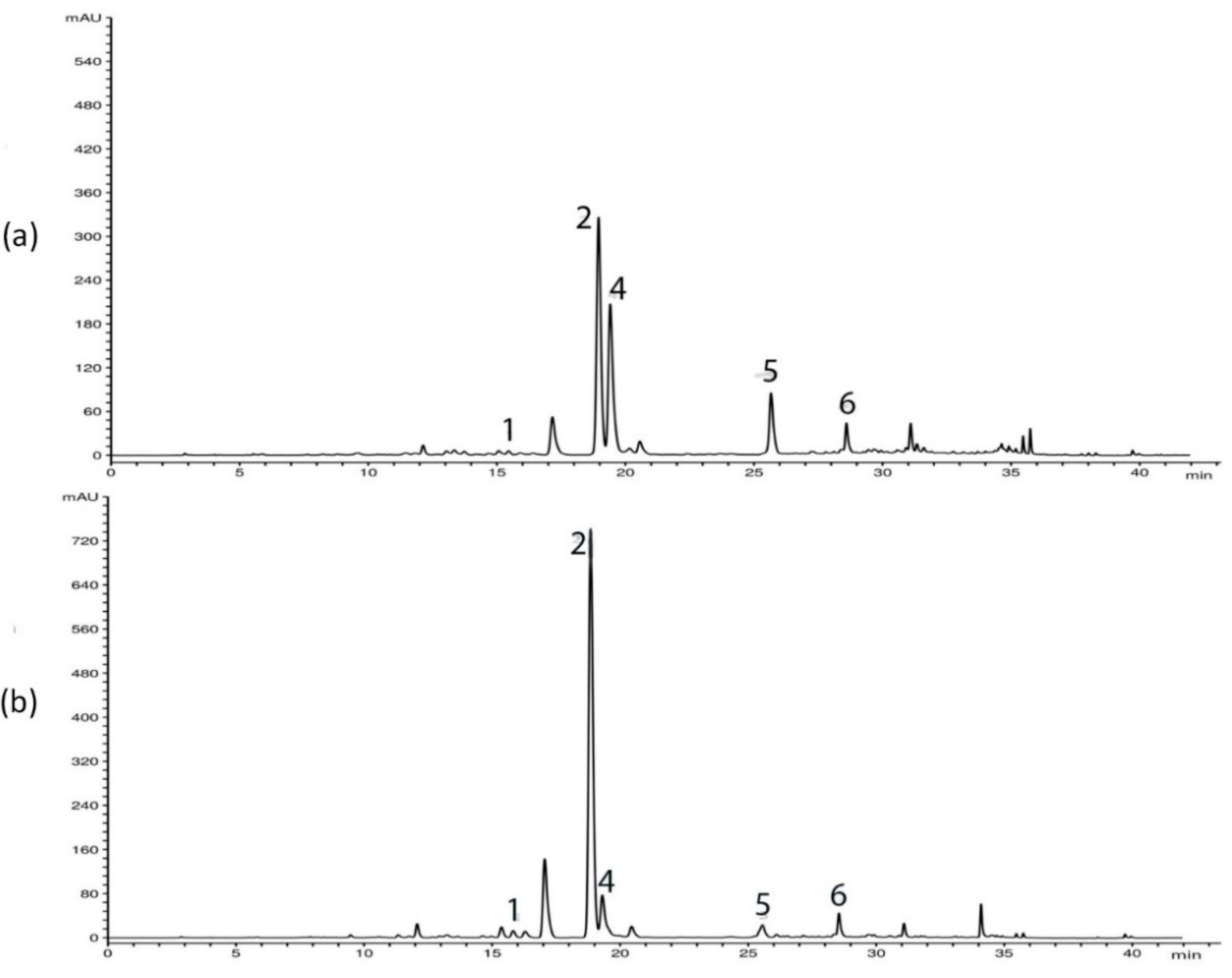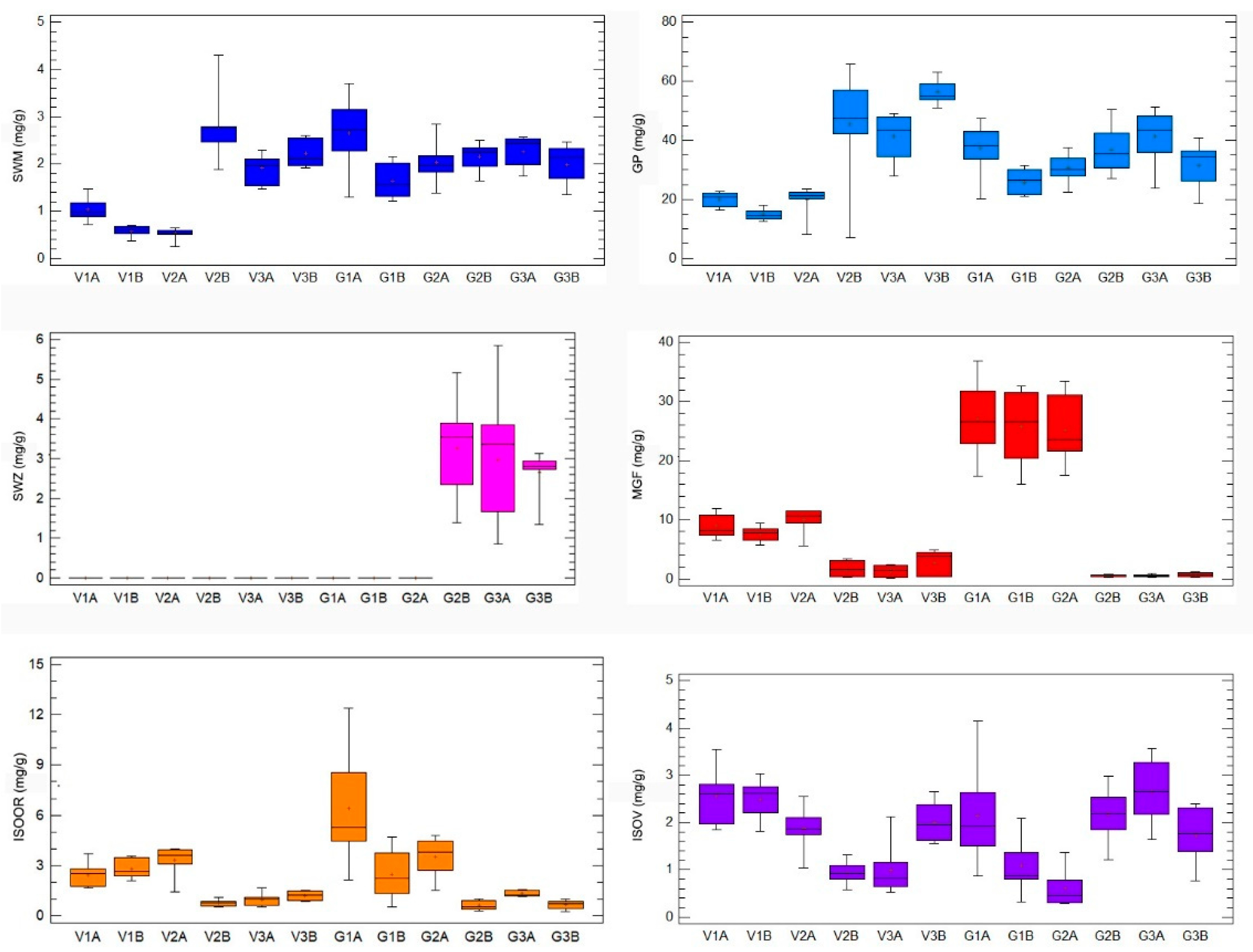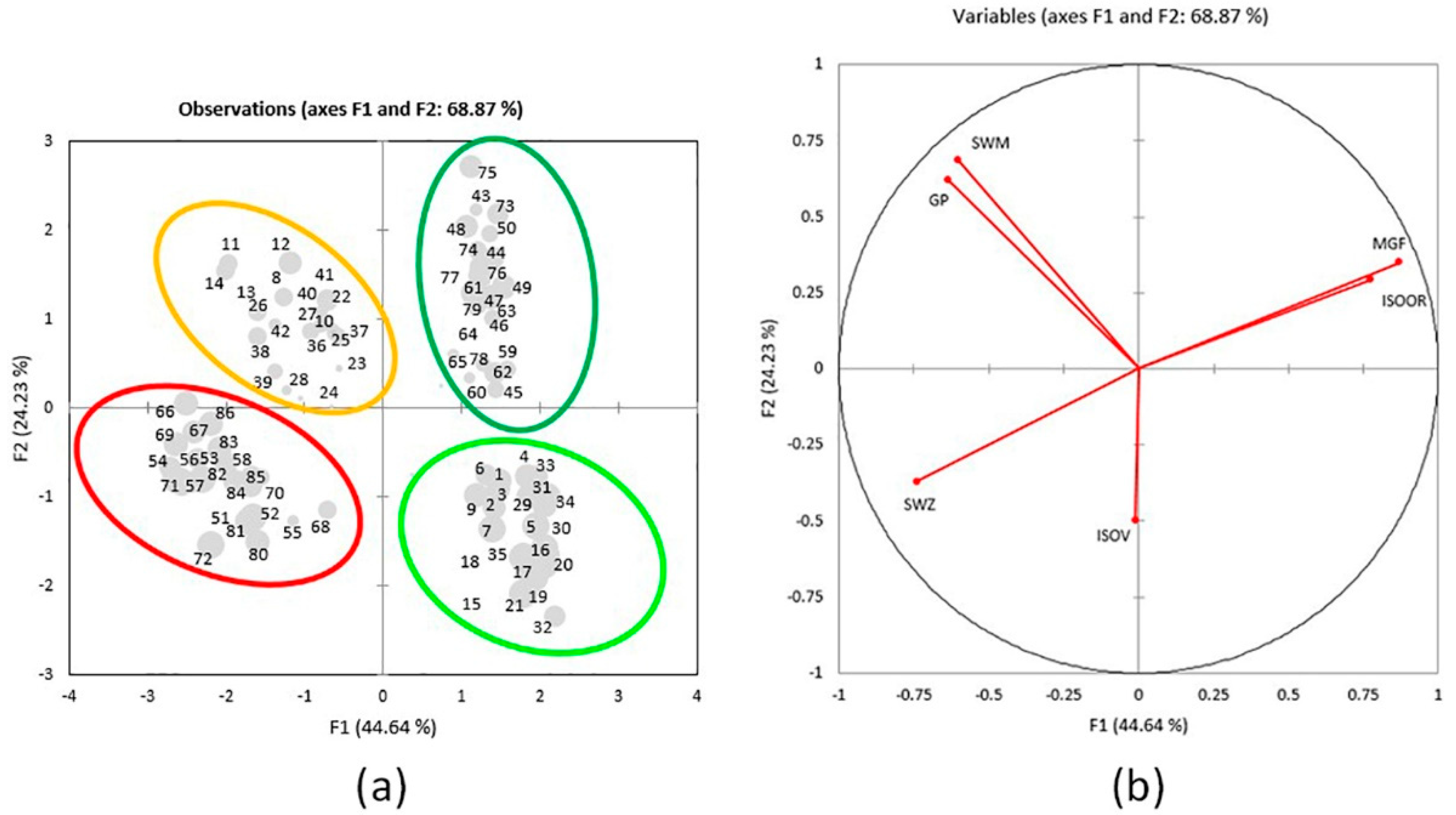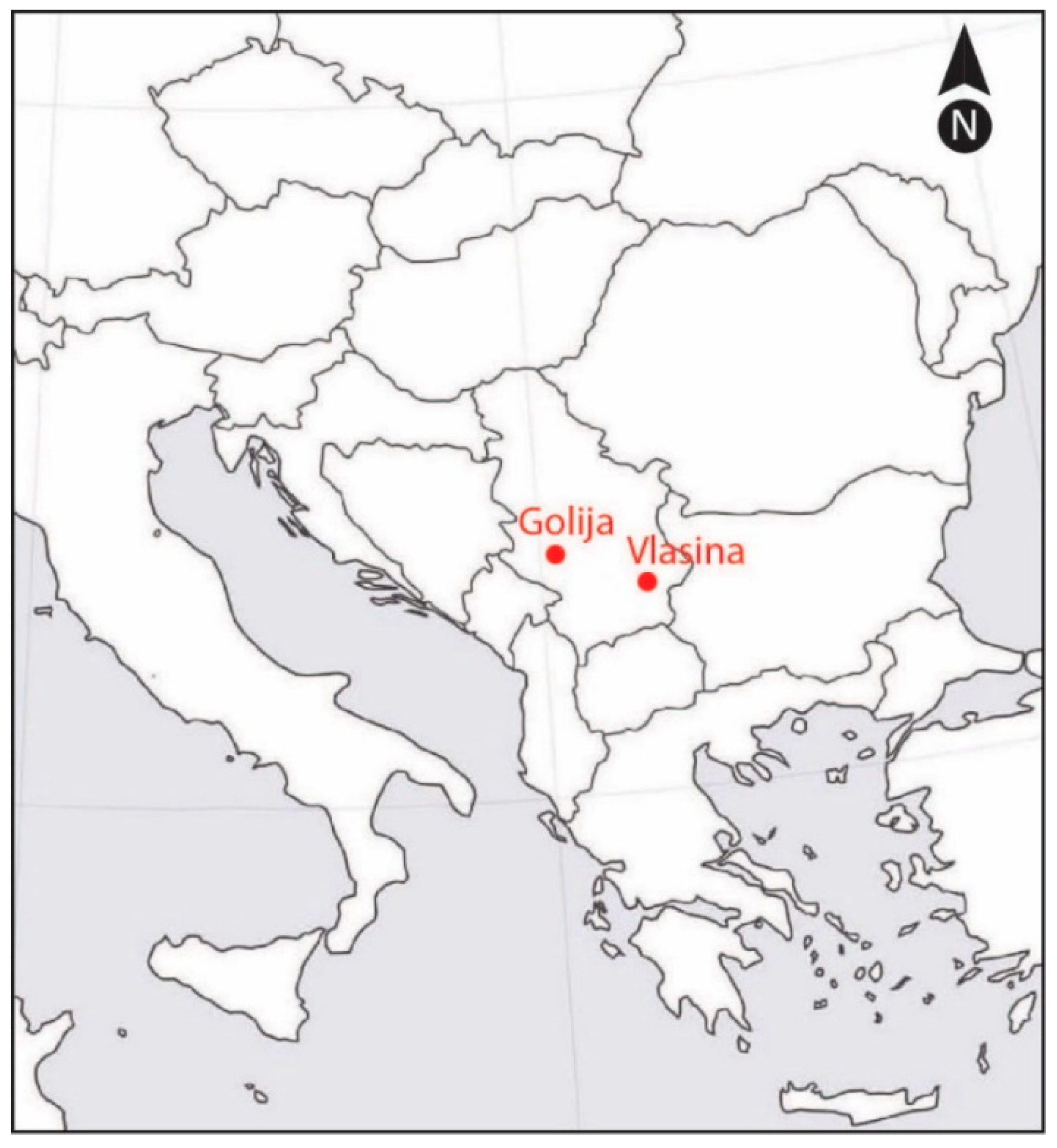Gentiana asclepiadea L. from Two High Mountainous Habitats: Inter- and Intrapopulation Variability Based on Species’ Phytochemistry
Abstract
1. Introduction
2. Results
3. Discussion
4. Materials and Methods
4.1. Study Sites
4.2. Plant Material and Sample Preparation
4.3. Chemical Analysis
4.3.1. Reagents and Chemicals
4.3.2. Extraction
4.3.3. HPLC Analysis
4.4. Statistical Analysis
5. Conclusions
Author Contributions
Funding
Institutional Review Board Statement
Informed Consent Statement
Data Availability Statement
Acknowledgments
Conflicts of Interest
References
- Zając, A.; Pindel, A. Review of the Willow Gentian, Gentiana asclepiadea L. Biodiversity 2011, 12, 181–185. [Google Scholar] [CrossRef]
- Pan, Y.; Zhao, Y.-L.; Zhang, J.; Li, W.-Y.; Wang, Y.-Z. Phytochemistry and Pharmacological Activities of the Genus Gentiana (Gentianaceae). Chem. Biodivers. 2016, 13, 107–150. [Google Scholar] [CrossRef]
- Josifović, M. Flora SR Srbije; Srpska Akademija Nauka i Umetnosti: Belgrade, Serbia, 1973; Volume 5. [Google Scholar]
- Sarić, M.R. Lekovite Biljke SR Srbije; Srpska Akademija Nauka i Umetnosti: Belgrade, Serbia, 1989. [Google Scholar]
- Gairola, S.; Shariff, N.M.; Bhatt, A.; Chandra Prakash, K. Influence of climate change on production of secondary chemicals in high altitude medicinal plants: Issues needs immediate attention. J. Med. Plants Res. 2010, 4, 1825–1829. [Google Scholar] [CrossRef]
- Körner, C.; Jetz, W.; Paulsen, J.; Payne, D.; Rudmann-Maurer, K.; Spehn, E.M. A global inventory of mountains for bio-geographical applications. Alp. Bot. 2017, 127, 1–15. [Google Scholar] [CrossRef]
- Nagy, L.; Grabherr, G.; Körner, C.; Thompson, D.B.A. Alpine Biodiversity in Europe; Ecological Studies; Springer: Berlin/Heidelberg, Germany, 2003; Volume 167. [Google Scholar] [CrossRef]
- Teramura, A.H.; Sullivan, J.H. Effects of UV-B radiation on photosynthesis and growth of terrestrial plants. Photosynth. Res. 1994, 39, 463–473. [Google Scholar] [CrossRef] [PubMed]
- Jansen, M.A.K.; Gaba, V.; Greenberg, B.M. Higher plants and UV-B radiation: Balancing damage, repair and acclimation. Trends Plant. Sci. 1998, 3, 131–135. [Google Scholar] [CrossRef]
- Sheahan, J.J. Sinapate esters provide greater UV-B attenuation than flavonoids in Arabidopsis thaliana (Brassicaceae). Am. J. Bot. 1996, 83, 679–686. [Google Scholar] [CrossRef]
- Paul, N. Plant responses to UV-B: Time to look beyond stratospheric ozone depletion? New Phytol. 2001, 150, 5–8. [Google Scholar] [CrossRef]
- Jaakola, L.; Hohtola, A. Effect of latitude on flavonoid biosynthesis in plants. Plant. Cell Environ. 2010, 33, 1239–1247. [Google Scholar] [CrossRef]
- Dean, J.C.; Kusaka, R.; Walsh, P.S.; Allais, F.; Zwier, T.S. Plant Sunscreens in the UV-B: Ultraviolet Spectroscopy of Jet-Cooled Sinapoyl Malate, Sinapic Acid, and Sinapate Ester Derivatives. J. Am. Chem. Soc. 2014, 136, 14780–14795. [Google Scholar] [CrossRef]
- Duan, Y.-W.; Zhang, T.-F.; Liu, J.-Q. Interannual fluctuations in floral longevity, pollinator visitation and pollination limitation of an alpine plant (Gentiana straminea Maxim., Gentianaceae) at two altitudes in the Qinghai-Tibetan Plateau. Plant. Syst. Evol. 2007, 267, 255–265. [Google Scholar] [CrossRef]
- Hodkinson, I.D. Terrestrial insects along elevation gradients: Species and community responses to altitude. Biol. Rev. 2005, 80, 489–513. [Google Scholar] [CrossRef] [PubMed]
- Bortenschlager, S. The Iceman’s environment. In The Iceman and His Natural Environment: Palaeobotanical Results; Bortenschlager, S., Oeggl, K., Eds.; The Man in the Ice; Springer: Vienna, Austria, 2000; pp. 11–24. [Google Scholar] [CrossRef]
- Yang, J.-L.; Liu, L.-L.; Shi, Y.-P. Phytochemicals and biological activities of Gentiana species. Nat. Prod. Commun. 2010, 5, 1934578X1000500432. [Google Scholar] [CrossRef]
- Georgieva, E.; Handjieva, N.; Popov, S.; Evstatieva, L. Comparative analysis of the volatiles from flowers and leaves of three Gentiana species. Biochem. Syst. Ecol. 2005, 33, 938–947. [Google Scholar] [CrossRef]
- Kozuharova, E.; Lapeva-Gjonova, A.; Shishiniova, M. Plant–insect interactions: Gentians, seed predators and parasitoid wasps. Arthropod-Plant. Interact. 2018, 12, 453–463. [Google Scholar] [CrossRef]
- Popović, Z.; Milošević, D.K.; Stefanović, M.; Vidaković, V.; Matić, R.; Janković, J.; Bojović, S. Variability of six secondary metabolites in plant parts and developmental stages in natural populations of rare Gentiana pneumonanthe. Plant. Biosyst. Int. J. Deal. Asp. Plant. Biol. 2020. [Google Scholar] [CrossRef]
- Popović, Z.; Matić, R.; Bojović, S.; Stefanović, M.; Vidaković, V. Ethnobotany and herbal medicine in modern complementary and alternative medicine: An overview of publications in the field of I&C medicine 2001–2013. J. Ethnopharmacol. 2016, 181, 182–192. [Google Scholar] [CrossRef]
- Szucs, Z.; Dános, B.; Nyiredy, S. Comparative analysis of the underground parts of Gentiana species by HPLC with diode-array and mass spectrometric detection. Chromatographia 2002, 56, S19–S23. [Google Scholar] [CrossRef]
- Olennikov, D.N.; Gadimli, A.I.; Isaev, J.I.; Kashchenko, N.I.; Prokopyev, A.S.; Kataeva, T.N.; Chirikova, N.K.; Vennos, C. Caucasian Gentiana Species: Untargeted LC-MS Metabolic Profiling, Antioxidant and Digestive Enzyme Inhibiting Activity of Six Plants. Metabolites 2019, 9, 271. [Google Scholar] [CrossRef]
- Popović, Z.; Matić, R.; Stefanović, M.; Vidaković, V.; Bojović, S. Chemodiversity in natural plant populations as a base for biodiversity conservation. In Biodiversity and Biomedicine; Ozturk, M., Egamberdieva, D., Pešić, M., Eds.; Academic Press: Cambridge, MA, USA, 2020; pp. 11–41. [Google Scholar] [CrossRef]
- Zhou, D.; Hou, Q.; Si, Q.; Liu, J.; Yang, H. Concentrations of the Active Constituents of the Tibetan Folk Medicine Qinjiao (Gentiana sect. Cruciata) within and between Taxonomic Species across the Qinghai-Tibetan Plateau. Chem. Biodivers. 2010, 7, 2088–2094. [Google Scholar] [CrossRef]
- Cao, X.-Y.; Wang, Z.-J.; Wang, Z.-Z. Comparative analysis of contents of four iridoid glucosides in different organs of four species of Gentiana L. J. Plant. Resour. Environ. 2012, 21, 58–63. [Google Scholar]
- Aiello, N.; Bontempo, R.; Vender, C. Use of morphological features and amarogentin content for characterization of wild yellow gentian (Gentiana lutea L.) populations in north-east Italy. Acta Bot. Gallica 2013, 160, 33–41. [Google Scholar] [CrossRef]
- Yang, H.; Liu, J.; Chen, S.; Hu, F.; Zhou, D. Spatial variation profiling of four phytochemical constituents in Gentiana straminea (Gentianaceae). J. Nat. Med. 2014, 68, 38–45. [Google Scholar] [CrossRef] [PubMed]
- Popović, Z.; Krstić-Milošević, D.; Stefanović, M.; Matić, R.; Vidaković, V.; Bojović, S. Chemical and Morphological Inter- and Intrapopulation Variability in Natural Populations of Gentiana pneumonanthe L. Chem. Biodivers. 2019, 16, e1800509. [Google Scholar] [CrossRef] [PubMed]
- Zhao, Y.; Yuan, T.; Wu, L.; Zhang, J.; Zuo, Z.; Wang, Y. Identification of Gentiana rigescens from different geographical origins based on HPLC and FTIR fingerprints. Anal. Methods 2020, 12, 2260–2271. [Google Scholar] [CrossRef]
- Lin, J.; Zhu, J.; Wang, Y.; Zhang, N.; Gober, H.-J.; Qiu, X.; Li, D.; Wang, L. Chinese single herbs and active ingredients for postmenopausal osteoporosis: From preclinical evidence to action mechanism. Biosci. Trends 2017, 11, 496–506. [Google Scholar] [CrossRef]
- Bowers, M.D. Iridoid Glycosides. In Herbivores: Their Interactions with Secondary Plant Metabolites, 2nd ed.; Rosenthal, G.A., Berenbaum, M.R., Eds.; Academic Press: San Diego, CA, USA, 1991; Volume 1, pp. 297–325. [Google Scholar] [CrossRef]
- Hostettmann, K.; Jacot-Guillarmod, A. Xanthones et C-glucosides flavoniques du genre Gentiana (section Cyclostigma). Phytochemistry 1977, 16, 481–482. [Google Scholar] [CrossRef]
- Rybczyński, J.J.; Davey, M.R.; Mikula, A. The Gentianaceae—Volume 2: Biotechnology and Applications; Springer: Berlin/Heidelberg, Germany, 2015. [Google Scholar] [CrossRef]
- Schmitz-Hoerner, R.; Weissenböck, G. Contribution of phenolic compounds to the UV-B screening capacity of developing barley primary leaves in relation to DNA damage and repair under elevated UV-B levels. Phytochemistry 2003, 64, 243–255. [Google Scholar] [CrossRef]
- Xu, Y.; Li, Y.; Maffucci, K.G.; Huang, L.; Zeng, R. Analytical Methods of Phytochemicals from the Genus Gentiana. Molecules 2017, 22, 2080. [Google Scholar] [CrossRef]
- Menković, N.; Šavikin-Fodulović, K.; Momcilović, I.; Grubišić, D. Quantitative Determination of Secoiridoid and γ-Pyrone Compounds in Gentiana lutea Cultured in vitro. Planta Med. 2000, 66, 96–98. [Google Scholar] [CrossRef] [PubMed]
- Kumar, A.; Memo, M.; Mastinu, A. Plant behaviour: An evolutionary response to the environment? Plant Biol. 2020, 22, 961–970. [Google Scholar] [CrossRef] [PubMed]
- Mahdavi, A.; Moradi, P.; Mastinu, A. Variation in Terpene Profiles of Thymus vulgaris in Water Deficit Stress Response. Molecules 2020, 25, 1091. [Google Scholar] [CrossRef] [PubMed]
- Hartmann, T. Diversity and variability of plant secondary metabolism: A mechanistic view. Entomol. Exp. Appl. 1996, 80, 177–188. [Google Scholar] [CrossRef]
- Kolosova, N.; Sherman, D.; Karlson, D.; Dudareva, N. Cellular and Subcellular Localization of S-Adenosyl-L-Methionine:Benzoic Acid Carboxyl Methyltransferase, the Enzyme Responsible for Biosynthesis of the Volatile Ester Methylbenzoate in Snapdragon Flowers. Plant. Physiol. 2001, 126, 956–964. [Google Scholar] [CrossRef]
- Pott, D.M.; Osorio, S.; Vallarino, J.G. From Central to Specialized Metabolism: An Overview of Some Secondary Compounds Derived From the Primary Metabolism for Their Role in Conferring Nutritional and Organoleptic Characteristics to Fruit. Front. Plant. Sci. 2019, 10, 835. [Google Scholar] [CrossRef]
- Ibanez, S.; Gallet, C.; Després, L. Plant Insecticidal Toxins in Ecological Networks. Toxins 2012, 4, 228–243. [Google Scholar] [CrossRef]
- Izhaki, I. Emodin—A secondary metabolite with multiple ecological functions in higher plants. New Phytol. 2002, 155, 205–217. [Google Scholar] [CrossRef]
- Bertin, C.; Yang, X.; Weston, L.A. The role of root exudates and allelochemicals in the rhizosphere. Plant. Soil 2003, 256, 67–83. [Google Scholar] [CrossRef]
- Flores, H.E.; Vivanco, J.M.; Loyola-Vargas, V.M. ‘Radicle’ biochemistry: The biology of root-specific metabolism. Trends Plant. Sci. 1999, 4, 220–226. [Google Scholar] [CrossRef]
- Wainhouse, D.; Ashburner, R.; Ward, E.; Rose, J. The effect of variation in light and nitrogen on growth and defence in young Sitka Spruce. Funct. Ecol. 1998, 12, 561–572. [Google Scholar] [CrossRef]
- Mattson, W.J.; Julkunen-Tiitto, R.; Herms, D.A. CO2 enrichment and carbon partitioning to phenolics: Do plant responses accord better with the protein competition or the growth differentiation balance models? Oikos 2005, 111, 337–347. [Google Scholar] [CrossRef]
- Rasmann, S.; Agrawal, A.A. In Defense of Roots: A Research Agenda for Studying Plant Resistance to Belowground Herbivory. Plant Physiol. 2008, 146, 875–880. [Google Scholar] [CrossRef] [PubMed]
- Fick, S.E.; Hijmans, R.J. WorldClim 2: New 1-km spatial resolution climate surfaces for global land areas. Int. J. Climatol. 2017, 37, 4302–4315. [Google Scholar] [CrossRef]





| Source 1 | Sum of Squares | df | Mean Square | F-Ratio | p-Value |
|---|---|---|---|---|---|
| Swertiamarin (SWM) | |||||
| (A) locality | 0.295823 | 1 | 0.295823 | 8.86 | 0.0409 |
| (B) population | 0.133747 | 4 | 0.0334368 | 0.22 | 0.9173 |
| (C) part | 0.909423 | 6 | 0.15157 | 47.18 | 0.00001 |
| residual | 0.237739 | 74 | 0.00321269 | ||
| Total (corrected) | 1.58586 | 85 | |||
| Gentiopicrin (GP) | |||||
| (A) locality | 0.0828173 | 1 | 0.0828173 | 2.3 | 0.2037 |
| (B) population | 0.144 | 4 | 0.0360001 | 0.12 | 0.9695 |
| (C) part | 1.77605 | 6 | 0.296008 | 19.07 | 0.00001 |
| residual | 1.14839 | 74 | 0.0155188 | ||
| Total (corrected) | 3.15653 | 85 | |||
| Mangiferin (MGF) | |||||
| (A) locality | 0.280816 | 1 | 0.280816 | 8.38 | 0.0443 |
| (B) population | 0.134121 | 4 | 0.0335302 | 0.01 | 0.9998 |
| (C) part | 20.8212 | 6 | 3.4702 | 162.47 | 0.00001 |
| residual | 1.58054 | 74 | 0.0213586 | ||
| Total (corrected) | 22.8178 | 85 | |||
| Isoorientin (ISOOR) | |||||
| (A) locality | 0.0151992 | 1 | 0.0151992 | 0.45 | 0.54 |
| (B) population | 0.135884 | 4 | 0.033971 | 0.06 | 0.9904 |
| (C) part | 3.17439 | 6 | 0.529066 | 44.35 | 0.00001 |
| residual | 0.882783 | 74 | 0.0119295 | ||
| Total (corrected) | 4.21135 | 85 | |||
| Isovitexin (ISOV) | |||||
| (A) locality | 0.00913338 | 1 | 0.00913338 | 0.14 | 0.7282 |
| (B) population | 0.263262 | 4 | 0.0658155 | 0.45 | 0.77 |
| (C) part | 0.877645 | 6 | 0.146274 | 18.3 | 0.00001 |
| residual | 0.591491 | 74 | 0.00799312 | ||
| Total (corrected) | 1.73869 | 85 | |||
| Sweroside (SWZ) | |||||
| (A) locality | 1.78663 | 1 | 1.78663 | 1015.34 | 0.00001 |
| (B) population | 0.00701807 | 4 | 0.00175452 | 0 | 1 |
| (C) part | 3.69257 | 6 | 0.615428 | 114.6 | 0.00001 |
| residual | 0.397395 | 74 | 0.0053702 | ||
| Total (corrected) | 5.89691 | 85 |
| F1 | F2 | Sum | |
|---|---|---|---|
| SWM | 0.365 | 0.472 | 0.837 |
| GP | 0.407 | 0.388 | 0.794 |
| MGF | 0.762 | 0.123 | 0.885 |
| ISOOR | 0.597 | 0.085 | 0.683 |
| ISOV | 0 | 0.248 | 0.248 |
| SWZ | 0.547 | 0.138 | 0.685 |
| Mountain | Location/Population | Latitude | Longitude | Altitude | MAT 1 (°C) | AP 1 (mm) |
|---|---|---|---|---|---|---|
| Vlasina | Del (V1) | 42.81444 | 22.27028 | 1352 | 5.42 | 720 |
| Vlasina | Dževrljanka (V2) | 42.79694 | 22.26222 | 1368 | 5.18 | 727 |
| Vlasina | Komančićeva mahala (V3) | 42.75528 | 22.33639 | 1280 | 5.75 | 705 |
| Golija | Bele vode (G1) | 43.41278 | 20.28361 | 1460 | 4.65 | 893 |
| Golija | Golijska reka (G2) | 43.36306 | 20.25667 | 1406 | 4.54 | 893 |
| Golija | Daićko jezero (G3) | 43.42444 | 20.26361 | 1455 | 4.89 | 879 |
Publisher’s Note: MDPI stays neutral with regard to jurisdictional claims in published maps and institutional affiliations. |
© 2021 by the authors. Licensee MDPI, Basel, Switzerland. This article is an open access article distributed under the terms and conditions of the Creative Commons Attribution (CC BY) license (http://creativecommons.org/licenses/by/4.0/).
Share and Cite
Popović, Z.; Krstić-Milošević, D.; Marković, M.; Vidaković, V.; Bojović, S. Gentiana asclepiadea L. from Two High Mountainous Habitats: Inter- and Intrapopulation Variability Based on Species’ Phytochemistry. Plants 2021, 10, 140. https://doi.org/10.3390/plants10010140
Popović Z, Krstić-Milošević D, Marković M, Vidaković V, Bojović S. Gentiana asclepiadea L. from Two High Mountainous Habitats: Inter- and Intrapopulation Variability Based on Species’ Phytochemistry. Plants. 2021; 10(1):140. https://doi.org/10.3390/plants10010140
Chicago/Turabian StylePopović, Zorica, Dijana Krstić-Milošević, Milena Marković, Vera Vidaković, and Srđan Bojović. 2021. "Gentiana asclepiadea L. from Two High Mountainous Habitats: Inter- and Intrapopulation Variability Based on Species’ Phytochemistry" Plants 10, no. 1: 140. https://doi.org/10.3390/plants10010140
APA StylePopović, Z., Krstić-Milošević, D., Marković, M., Vidaković, V., & Bojović, S. (2021). Gentiana asclepiadea L. from Two High Mountainous Habitats: Inter- and Intrapopulation Variability Based on Species’ Phytochemistry. Plants, 10(1), 140. https://doi.org/10.3390/plants10010140





